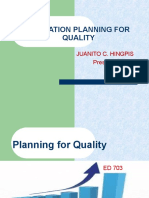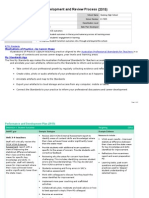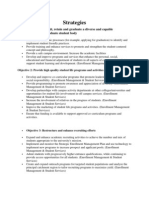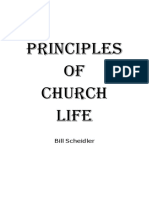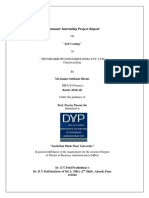Sample Visit Report
Sample Visit Report
Uploaded by
Lydia D. GalinganCopyright:
Available Formats
Sample Visit Report
Sample Visit Report
Uploaded by
Lydia D. GalinganOriginal Description:
Copyright
Available Formats
Share this document
Did you find this document useful?
Is this content inappropriate?
Copyright:
Available Formats
Sample Visit Report
Sample Visit Report
Uploaded by
Lydia D. GalinganCopyright:
Available Formats
Mentor Visit Report (Standard by Standard):
[Name of Institution], [Name of Business Academic Unit]
[Insert Name Dean/Head of unit], [Insert Name accreditation contact person if different
than Dean/Head of unit]
[Insert Name of Mentor], Mentor
[Insert Visit Dates]
Introduction
This report is based on my first site visit to [name of institution] .
[Insert name of accreditation unit was well organized for the site visit, which included a
range of meetings with faculty, staff and students. (Please see attached visit schedule.)
During the visit I had meetings with the Director of Admissions, faculty members,
students, Deputy Superintendent for Academics and Dean of the Faculty. All parties
were genuinely supportive of the pursuit of AACSB accreditation.
In addition to learning more about the unique culture of [name of institution], the main
issues addressed during this first visit focused on the concerns outlined by the Initial
Accreditation Committee (IAC) which include:
[Insert here concerns highlighted in IAC decision letter] for this example visit report the
following concern were taken out of the IAC decision letter]
1. Diversity issues
2. Development of mission, strategic management plan and continuous
improvement processes
3. Sufficiency of resources
4. Clarification of scholarly academic faculty
5. Adequate curriculum coverage
6. Future levels of Intellectual Contribution
Mentor Visit Report
[Name of Institution], [Name of Business Academic Unit]
Date
AACSB ELIGIBILITY PROCEDURES QUESTIONS/COMMENTS
A. The school must encourage and support ethical behavior by
students, faculty, administrators, and professional staff.
B. The school maintains a collegiate environment in which students,
faculty, administrators, professional staff, and practitioners interact and
collaborate in support of learning, scholarship, and community
engagement.
C. The school must demonstrate a commitment to address, engage,
and respond to current and emerging corporate social responsibility
issues (e.g., diversity, sustainable development, environmental
sustainability, and globalization of economic activity across cultures)
through its policies, procedures, curricula, research, and/or outreach
activities.
D. An applicant for AACSB accreditation must be a well-defined,
established entity and a member of AACSB International in good
standing. The entity seeking AACSB accreditation may be an institution
authorized to award bachelors degrees or higher (in business) or under
certain circumstances a business academic unit within a larger
institution.
E. The school must be structured to ensure proper oversight,
accountability, and responsibility for the schools operations; must be
supported by continuing resources (human, financial, infrastructure, and
physical); and must have policies and processes for continuous
improvement.
F. All degree programs included in the AACSB accreditation review
must demonstrate continuing adherence to AACSB accreditation
standards. Schools are expected to maintain and provide timely,
accurate information in support of each accreditation review.
Mentor Visit Report
[Name of Institution], [Name of Business Academic Unit]
Date
AACSB STRATEGIC MGMT. AND STANDARDS QUESTIONS/COMMENTS
1. Mission, Impact, and Innovation
The school articulates a clear and distinctive mission, the expected
outcomes this mission implies, and strategies outlining how these
outcomes will be achieved. The school has a history of achievement and
improvement and specifies future actions for continuous improvement
and innovation consistent with this mission, expected outcomes, and
strategies.
2. Intellectual Contributions, Impact, and Alignment with Mission
The school produces high-quality intellectual contributions that are
consistent with its mission, expected outcomes, and strategies and that
impact the theory, practice, and teaching of business and management.
3. Financial Strategies and Allocation Of Resources
The school has financial strategies to provide resources appropriate to,
and sufficient for, achieving its mission and action items.
AACSB PARTICIPANTS STUDENTS, FACULTY, AND
QUESTIONS/COMMENTS
PROFESSIONAL STAFF STANDARDS
4. Student Admissions, Progression, and Career Development
Policies and procedures for student admissions, as well as those that
ensure academic progression toward degree completion, and supporting
career development are clear, effective, consistently applied, and aligned
with the school's mission, expected outcomes, and strategies.
5. Faculty Sufficiency and Deployment
The school maintains and deploys a faculty sufficient to ensure quality
outcomes across the range of degree programs it offers and to achieve
other components of its mission. Students in all programs, disciplines,
locations, and delivery modes have the opportunity to receive instruction
from appropriately qualified faculty.
6. Faculty Management and Support
The school has well-documented and well-communicated processes to
manage and support faculty members over the progression of their
careers that are consistent with the schools mission, expected
outcomes, and strategies.
Mentor Visit Report
[Name of Institution], [Name of Business Academic Unit]
Date
7. Professional Staff Sufficiency and Deployment
The school maintains and deploys professional staff and/or services
sufficient to ensure quality outcomes across the range of degree
programs it offers and to achieve other components of its mission
AACSB LEARNING AND TEACHING STANDARDS QUESTIONS/COMMENTS
8. Curricula Management and Assurance Of Learning
The school uses well-documented, systematic processes for determining
and revising degree program learning goals; designing, delivering, and
improving degree program curricula to achieve learning goals; and
demonstrating that degree program learning goals have been met.
9. Curriculum Content
Curriculum content is appropriate to general expectations for the degree
program type and learning goals.
10. Student-Faculty Interactions
Curricula facilitate student-faculty and student-student interactions
appropriate to the program type and achievement of learning goals..
11. Degree Program Educational Level, Structure, and Equivalence
Degree program structure and design, including the normal time-to-
degree, are appropriate to the level of the degree program and ensure
achievement of high-quality learning outcomes. Programs resulting in the
same degree credential are structured and designed to ensure
equivalence.
12. Teaching Effectiveness
The school has policies and processes to enhance the teaching
effectiveness of faculty and professional staff involved with teaching
across the range of its educational programs and delivery modes.
AACSB ACADEMIC AND PROFESSIONAL ENGAGEMENT QUESTIONS/COMMENTS
STANDARDS
13. Student Academic and Professional Engagement
Curricula facilitate student academic and professional engagement
appropriate to the degree program type and learning goals.
Mentor Visit Report
[Name of Institution], [Name of Business Academic Unit]
Date
14. Executive Education
If applicable, executive education (activities not leading to a degree)
complements teaching and learning in degree programs and intellectual
contributions. The school has appropriate processes to ensure high
quality in meeting client expectations and continuous improvement in
executive education programs.
15. Faculty Qualifications And Engagement
The school maintains and strategically deploys participating and
supporting faculty who collectively and individually demonstrate
significant academic and professional engagement that sustains the
intellectual capital necessary to support high-quality outcomes consistent
with the schools mission and strategies.
Additional comments:
Mentor Visit Report
[Name of Institution], [Name of Business Academic Unit]
Date
Conclusion
In summary, I consider [name of institution] ready to move forward in pursuit of
accreditation. The upper administration, faculty and students are supportive and
adequate resources appear available. I suggest the following tentative schedule:
20XX
January June
Faculty meets on a regular basis to prepare documentation consistent with the
accreditation standards and areas identified by the Mentor and the IAC.
July/August
Visit by Mentor to finalize the Strategic Plan and Initial Self Evaluation Report (iSER)
November/December
Submit the Strategic Plan and iSER to the AACSB Initial Accreditation Committee
Mentor Visit Report
[Name of Institution], [Name of Business Academic Unit]
Date
You might also like
- Strategic Healthcare Management: Planning and Execution, Third EditionFrom EverandStrategic Healthcare Management: Planning and Execution, Third EditionNo ratings yet
- Management of Healthcare Organizations: An Introduction, Fourth EditionFrom EverandManagement of Healthcare Organizations: An Introduction, Fourth EditionNo ratings yet
- Unlocking the Performance Potential Complete Self-Assessment GuideFrom EverandUnlocking the Performance Potential Complete Self-Assessment GuideNo ratings yet
- Sample Mentor Visit ReportDocument5 pagesSample Mentor Visit ReportrehanNo ratings yet
- Sample Mentor Visit ReportDocument5 pagesSample Mentor Visit ReportJoe ArmandaNo ratings yet
- Core PrincipleDocument7 pagesCore PrincipleAngelica Joy RosarioNo ratings yet
- National Competency-Based Standards For School Heads (NCBS-SH)Document6 pagesNational Competency-Based Standards For School Heads (NCBS-SH)Freshie Pasco100% (1)
- CV AssaignmentDocument10 pagesCV AssaignmentBasem AbdelrahmanNo ratings yet
- Culturally Competent School-GuidelinesDocument6 pagesCulturally Competent School-GuidelinesClaire Aguinaldo BeronillaNo ratings yet
- AACSB AccreditationDocument3 pagesAACSB AccreditationYen TengNo ratings yet
- Overarching Goals of The Performance Management ProcessDocument3 pagesOverarching Goals of The Performance Management ProcessMayesha MehnazNo ratings yet
- Gap Analysis: University Business SchoolDocument17 pagesGap Analysis: University Business SchoolLaarnie R. ElardeNo ratings yet
- Changing Perceptions About Business Education & TheDocument22 pagesChanging Perceptions About Business Education & TheT Shyam SundarNo ratings yet
- Teaching Portfolio TemplateDocument6 pagesTeaching Portfolio TemplateMatthew SibandaNo ratings yet
- Accreditation StandardsDocument20 pagesAccreditation StandardsAbraxas LuchenkoNo ratings yet
- Chapter 12 PART 1 Roles and Competencies Od School HeadsDocument27 pagesChapter 12 PART 1 Roles and Competencies Od School HeadsJEZZEL A. RABENo ratings yet
- Deped Order No. 32, S. 2010Document7 pagesDeped Order No. 32, S. 2010HazeDialino67% (3)
- Principal Rubric - Tyisha NelsonDocument13 pagesPrincipal Rubric - Tyisha Nelsonapi-254968708No ratings yet
- Education Planning For QualityDocument44 pagesEducation Planning For QualityMabuza Dumisa97% (29)
- JD Cakes Sausage DogDocument2 pagesJD Cakes Sausage DogJohn SmithNo ratings yet
- Education Planning For Quality ReportDocument46 pagesEducation Planning For Quality Reportnaiar kramNo ratings yet
- School Improvement and Innovation Projects (SIIP)Document35 pagesSchool Improvement and Innovation Projects (SIIP)Enric T. Sanchez100% (2)
- Principal Evaluation InstrumentDocument10 pagesPrincipal Evaluation InstrumentJoy NapierNo ratings yet
- Appraisal of Teaching by Prof. Uzma QurashiDocument28 pagesAppraisal of Teaching by Prof. Uzma QurashinailaNo ratings yet
- 1 2curriculum Narrative ProfileDocument76 pages1 2curriculum Narrative Profilepeter cuevasNo ratings yet
- Graduate Profile Outcomes GDTE 2016Document4 pagesGraduate Profile Outcomes GDTE 2016Bronwyn HegartyNo ratings yet
- Juwariyah Islam Dan Filsafatilmu Dalam Pengembangan PendidikanDocument13 pagesJuwariyah Islam Dan Filsafatilmu Dalam Pengembangan PendidikanelektroftuhNo ratings yet
- New York City College of Technology Faculty: Professional Development PlanDocument3 pagesNew York City College of Technology Faculty: Professional Development PlanRodrick Sonajo RamosNo ratings yet
- Assistant Professor Responsibilities and DutiesDocument3 pagesAssistant Professor Responsibilities and DutiesKanha RathoreNo ratings yet
- QEC Presentation at LSEDocument24 pagesQEC Presentation at LSENadeem MustafaNo ratings yet
- SMS FPs AccredQualityMgr June18Document7 pagesSMS FPs AccredQualityMgr June18Dr-Syed Ali TarekNo ratings yet
- GCFE Team Leader Childcare March 2015Document5 pagesGCFE Team Leader Childcare March 2015Candice HurstNo ratings yet
- Teachers ManagementDocument3 pagesTeachers Managementsmartdesigner98No ratings yet
- Part-Time Lecturer Job Spec - HospitalityDocument8 pagesPart-Time Lecturer Job Spec - Hospitalityalicedyson55No ratings yet
- Schlauderaff Wts 7-8 EntryDocument22 pagesSchlauderaff Wts 7-8 Entryapi-289782637No ratings yet
- Charges For Committees 2011-12Document3 pagesCharges For Committees 2011-12marie_gardner_2No ratings yet
- Curriculum Evaluation Research PaperDocument9 pagesCurriculum Evaluation Research PaperagudocheryljaneNo ratings yet
- Lakendra Simon: Professional Objective and ProfileDocument3 pagesLakendra Simon: Professional Objective and Profileapi-461688620No ratings yet
- Purpose of Strategic Management in Educational InstitutesDocument8 pagesPurpose of Strategic Management in Educational InstitutesrunaemranNo ratings yet
- Administrative Setup: Responsibility & AuthorityDocument17 pagesAdministrative Setup: Responsibility & AuthorityKumar KrNo ratings yet
- Teaching Class Employee Performance and Development PlanDocument17 pagesTeaching Class Employee Performance and Development Planapi-298158473No ratings yet
- Strategic Planning PacketDocument13 pagesStrategic Planning Packetapi-285517817No ratings yet
- Strategic Plan: School of Business AdministrationDocument16 pagesStrategic Plan: School of Business AdministrationmadihasaleemsNo ratings yet
- 2015 Sample Goals and Evidence MarchDocument9 pages2015 Sample Goals and Evidence Marchapi-245840103No ratings yet
- Company Structure 2Document39 pagesCompany Structure 2Brute1989No ratings yet
- JD Ps For Lecturer in ScienceDocument5 pagesJD Ps For Lecturer in ScienceZaib RehmanNo ratings yet
- Topic 7 Deepika Managements File 1. Job DescriptionDocument11 pagesTopic 7 Deepika Managements File 1. Job Descriptionpreet kaurNo ratings yet
- Edfs-22-2023-24 2Document14 pagesEdfs-22-2023-24 2ocampoalbertaceNo ratings yet
- SiteDocument20 pagesSiteNAYNAYNo ratings yet
- Bsu TeachingexcellenceDocument12 pagesBsu Teachingexcellenceapi-194946381No ratings yet
- Aarsh Colleage Principal EvaluationDocument20 pagesAarsh Colleage Principal EvaluationArya SamajNo ratings yet
- JD - Head of Academic AffairsDocument2 pagesJD - Head of Academic AffairsJohn SmithNo ratings yet
- Assessmnt PaperDocument5 pagesAssessmnt PaperAbdulSalamNo ratings yet
- AgendumDocument7 pagesAgendumjheiiyanng2002No ratings yet
- Certification For ESC SchoolsDocument105 pagesCertification For ESC SchoolsHoniel091112100% (4)
- CPD Policy Adopted Jan 08Document22 pagesCPD Policy Adopted Jan 08BCCCSNo ratings yet
- Learning and Development Policy and ProcedureDocument6 pagesLearning and Development Policy and ProcedureAva FerdinandNo ratings yet
- Quality ManagementDocument25 pagesQuality ManagementEzhilarasiNo ratings yet
- Strategies: Strategic Goal I: Recruit, Retain and Graduate A Diverse and Capable Undergraduate and Graduate Student BodyDocument6 pagesStrategies: Strategic Goal I: Recruit, Retain and Graduate A Diverse and Capable Undergraduate and Graduate Student BodyStephen CollinsNo ratings yet
- Chapter 25 - The Body of Christ: PurposeDocument3 pagesChapter 25 - The Body of Christ: PurposeLydia D. GalinganNo ratings yet
- Charting SystemsDocument4 pagesCharting SystemsLydia D. GalinganNo ratings yet
- Stresses Caused by A Point LoadDocument8 pagesStresses Caused by A Point LoadLydia D. GalinganNo ratings yet
- Principles of Church Life A4 PDFDocument97 pagesPrinciples of Church Life A4 PDFLydia D. Galingan100% (3)
- Roadway Classification Exceedance Probability Return Period: Q K C I ADocument2 pagesRoadway Classification Exceedance Probability Return Period: Q K C I ALydia D. GalinganNo ratings yet
- Galingan, Maureen Joy DDocument2 pagesGalingan, Maureen Joy DLydia D. GalinganNo ratings yet
- Conjugate Beam Method SLUDocument41 pagesConjugate Beam Method SLULydia D. GalinganNo ratings yet
- Qualification of Board MembersDocument2 pagesQualification of Board MembersLydia D. GalinganNo ratings yet
- Prelims Homework 01: Compute The in The Beam Using - Show Complete Solution and Limit Answer ToDocument1 pagePrelims Homework 01: Compute The in The Beam Using - Show Complete Solution and Limit Answer ToLydia D. GalinganNo ratings yet
- Geometric Deflection Methods PDFDocument51 pagesGeometric Deflection Methods PDFLydia D. GalinganNo ratings yet
- Jasir Syed Project (208519684052)Document76 pagesJasir Syed Project (208519684052)Ishika AgarwalNo ratings yet
- MATS LIT P1 GR11 MEMO NOV2022 - EnglishDocument7 pagesMATS LIT P1 GR11 MEMO NOV2022 - EnglishBonolo RamofoloNo ratings yet
- IBRD Information Statement FY23Document159 pagesIBRD Information Statement FY23pupusmyus3No ratings yet
- Ilovepdf MergedDocument20 pagesIlovepdf MergedSangeeth School of MusicNo ratings yet
- Project "We Like": Presented By:Chirag Kapoor HPGD/JL17/3669Document59 pagesProject "We Like": Presented By:Chirag Kapoor HPGD/JL17/3669Chirag KapoorNo ratings yet
- King of Marketing NotesDocument95 pagesKing of Marketing NotesAshish TrivediNo ratings yet
- The Economic Problem: 1) The Production Possibilities Frontier Is The Boundary BetweenDocument8 pagesThe Economic Problem: 1) The Production Possibilities Frontier Is The Boundary Betweenhantu hantuNo ratings yet
- A-346 Tanglao, Allyza U. (Narrative Report)Document67 pagesA-346 Tanglao, Allyza U. (Narrative Report)Allyza TanglaoNo ratings yet
- Bank TransferDocument1 pageBank TransferFareed KhanNo ratings yet
- Chapter 1 The Strategic Elements of Product DevelopmentDocument4 pagesChapter 1 The Strategic Elements of Product DevelopmentmanoNo ratings yet
- A Review of Employees' Well-Being, Psychological Factors and Its Effect On Job Performance LiteratureDocument12 pagesA Review of Employees' Well-Being, Psychological Factors and Its Effect On Job Performance LiteratureRedgie G. GabaneNo ratings yet
- A Summer Internship Project Report: "Job Costing"Document17 pagesA Summer Internship Project Report: "Job Costing"Kshirsagar Abhijeet0% (1)
- Ma40324061 KemipexDocument1 pageMa40324061 Kemipexsarahbrillante20No ratings yet
- 3dprint Mediakit 062317Document7 pages3dprint Mediakit 062317RajeshNo ratings yet
- Citywide Youth Supports Infrastructure - A Jobs Creation Strategy?Document14 pagesCitywide Youth Supports Infrastructure - A Jobs Creation Strategy?Daniel F. BassillNo ratings yet
- Accounting PoliciesDocument6 pagesAccounting PoliciesShalini TiwariNo ratings yet
- BRisk Report of Ve Commercial Vehicles Limited - 307948 - 01-08-2023Document103 pagesBRisk Report of Ve Commercial Vehicles Limited - 307948 - 01-08-2023Preeti A MishraNo ratings yet
- Target-CostDocument3 pagesTarget-CostJennelNo ratings yet
- Marketing PlanDocument18 pagesMarketing PlannaphNo ratings yet
- "Have A Rice Day": Tandoc National High SchoolDocument4 pages"Have A Rice Day": Tandoc National High SchoolBrit VenturaNo ratings yet
- CH 1 CLASS 11 BST TEST-02-05-2024 - With AnswerDocument3 pagesCH 1 CLASS 11 BST TEST-02-05-2024 - With AnswerAnoop SainiNo ratings yet
- Mipfm Vol. 4 No. 3 - (220922) - 1-3Document3 pagesMipfm Vol. 4 No. 3 - (220922) - 1-3Ameenul Ummah Bin SallehuddinNo ratings yet
- Business Processes and ER1Document12 pagesBusiness Processes and ER1Rose Anne BautistaNo ratings yet
- KITEX Idegenforgalmi Szaknyelvi Vizsga Task Sheet ListeningDocument12 pagesKITEX Idegenforgalmi Szaknyelvi Vizsga Task Sheet ListeningNoémi JuhászNo ratings yet
- Bill of LadingDocument2 pagesBill of LadingIsolinoGatoSardinaNo ratings yet
- Competitive Profile MatrixDocument9 pagesCompetitive Profile MatrixJayNo ratings yet
- Bud Light 2Document5 pagesBud Light 2api-686124613No ratings yet
- Prosultative Selling - Mike PilcherDocument119 pagesProsultative Selling - Mike PilcherMike PilcherNo ratings yet
- Angeline Fierro ResumeDocument1 pageAngeline Fierro Resumeapi-534118354No ratings yet
- Lumapitsa Mesa NG OFFICER OF THE DAY at Lumagdasa LOG BOOKDocument5 pagesLumapitsa Mesa NG OFFICER OF THE DAY at Lumagdasa LOG BOOKRvbrRubaNo ratings yet





















